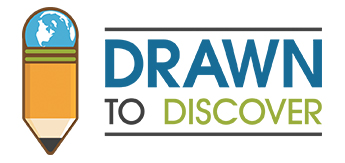In a recent podcast with my new company Drawn To Discover, we examined a conversation between our co-founders, Wendy Halperin and Brian Goodman, and Dr. Karin James, neuroscientist at Indiana University-Bloomington. Dr. James, director of The Cognition and Action Neuroimaging Lab (CANLab), focuses her research on the neural correlates of learning in humans. Generally speaking, her work explores “how motor experiences can influence visual recognition in both adults and children, and how the brain changes in response to specific experiences.”

Listening to the interview, we gleaned 7 key aspects for early literacy development that we thought were pertinent for parents of young children. You can listen to our discussion and hear from Dr. James in podcast episode 3 and episode 4. Additionally, because the conversation sparked many more connections and ideas than could fit in a single podcast – even one that expanded over two episodes – I decided to elaborate more here. Please share your thoughts and experiences in our comments section. I’d love to hear from you!
A quick word about the list itself
- First, the list is not in order of importance. It is simply an extension of the conversation with Dr. James and thus mirrors that flow.
- Second, the list is not as finely manicured grammatically as I normally would like. Usually, when I create lists for organizations or pneumonic acronyms for students, I like each item to follow the same grammatical pattern (e.g., verb/adverb, as in “Choose Wisely;” or verb/noun, as in “Provide Guidance”). This trait helps keep the lists concise, consistent and more amenable to signage and slogans. For our purposes here, I’m following the advice of Dr. James and allowing for an element of messiness and variety.
- Third, this list is not exhaustive nor is it a validated measure. It is intended as a handy reference and a jumping off point for your own exploration into early literacy.
- Fourth, our discussion was primarily focused on children ages 4-7. This list should be viewed in that context.
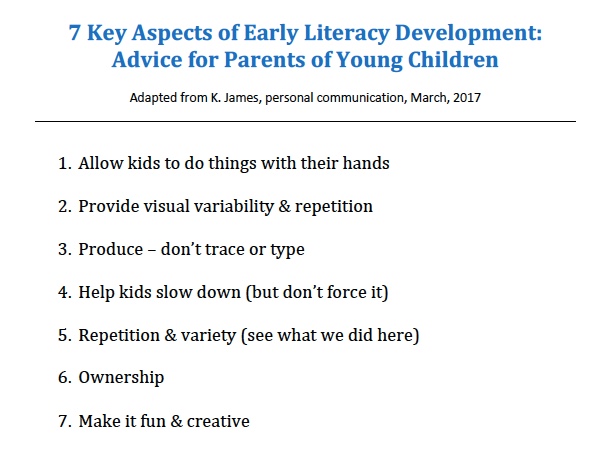
1) Allow kids to do things with their hands
I’m going to start with the obvious: babies love to explore. Little children love to explore, they get their hands into everything. Why else do we have to baby proof our homes? And, while it may be obvious that such exploration helps children learn about their environment and the world around them, it might not be so obvious, however, that doing things with their hands also builds academic skills for later. One, the more young children use their hands, the more they build their fine motor skills, their finger skills, and their manual dexterity. Such motor control and dexterity will help them later with forming letters and words. This motor control improves handwriting skills, which, in turn, improve written expression and literacy.
So break out the Legos, blocks, crayons, watercolors, and puzzles. Let your child dig in the dirt or sand. Plant a garden. Show them how to knit. Let them draw and create with pencils and crayons. Allow your child do as much as they can with their hands and make it fun!

2) Provide visual variability & repetition
Novelty is important to the human brain. Things that are novel or new are more likely to catch our attention. For young children, novelty is all around them. This is a great opportunity to seize that natural curiosity and introduce them to various new and fun activities. The more they explore, the more connections they make in their brain – the more neural pathways they build. All these novel activities increase brain activity and increase learning. We hear parents talk about how their children are like sponges at this age – they soak up so much. And it is true, the brain is incredibly malleable and the young brain grows at an enormous rate. Children really do have an immense capacity to learn. And, the best part is: learning is exciting. They enjoy it!
Nothing done once works. When we provide our children with these various opportunities and experiences, it is important that we allow for repeated experiences. Giving children a chance to do something over and over again helps instill that learning. That’s why children are always asking, “Again, again!” Seeing and doing repeatedly provide richer experiences and deeper learning.
3) Produce – don’t trace or type
Letter learning is the best predictor of later reading. The best way for children to learn letters is by producing them themselves. That is, children need to draw and write letters by hand with either crayons or pencils. They need the chance to create these letters in a variety of ways. Children need to see a variety of forms of letters to help build stronger neural pathways. Tracing or typing letters does not expose them such variances. They only learn one, uniform type (no pun intended). As Dr. James’s own work has shown, tracing does not create the same amount of brain activation that copying does. This is most likely due to the lack of variability (see image below).

Children need their own examples because their own examples are messy and messy is good for learning. All these different examples build a sort of database of knowledge – they create a strong schema. This broad schema and pattern recognition is an obstacle right now for developer of artificial intelligence. It is difficult to program such a wide-range of examples for A.I. to correctly identify. Humans, however, have a natural proclivity for this.
4) Help kids slow down (but don’t force it)
One of the greatest gifts we can give our children is the gift of time. That can be more and more difficult in our faster and faster paced world. And, its importance may be greater than ever. When we allow our children time to create and explore, we allow for that natural learning and we allow their brains time to process. The brain needs stimulation, however it also needs time to process that stimulation. Free play and time for imagination provide the brain with the time needed to solidify new experiences and learning into the long-term memory. Over-stimulation leads to fatigue and prevents new knowledge from entering long-term memory stores.
Similarly, when our children are learning a new skill such as writing, we want to encourage them to take their time so they can master that skill. Going slowly can help them physically and mentally master a skill such as writing. On the flip side, however, some children struggle to slow down and we must be cautious not to over-emphasize precision. We want our children to learn and improve their handwriting, and we don’t want to make this skill a burdensome chore that they loathe. Striking the right balance will be essential for parents and that balance will vary from child to child. It is better for children’s long-term learning that they create and produce regardless of how messy those creations are.
5) Repetition & variety (see what we did here)
I’ve listed these items again, and in a slightly nuanced form, in order to stress their importance. It is also important to point out here that repetition does not equal “drill and kill.” Repeated practice and exposure will help improve children’s knowledge and skill, but this doesn’t mean we should require them to sit down and churn out letter after letter factory style. The repetition is more about repeated exposure and repeated opportunity. Again, children will naturally do this. How often do we see children line up items in a row, take them down, and line them up again? Their brains are naturally attuned to this need for repetition.
6) Ownership
This aspect takes us back to the need for children to produce versus trace or click & swipe. When children produce their own letters, words, or drawing they have a sense of ownership. We see the pride and joy on their faces. Their ownership in their creation builds self-confidence and builds self-efficacy. Self-efficacy is a concept developed by Albert Bandura and relates to a person’s belief that they have the power to achieve or succeed in something. The more mastery children develop, the more they believe in themselves and the more they are willing to try new things.
So let your children draw words and pictures by hand. Let them write letters backward and suns with faces on them. Indeed, this is why God created refrigerators – to display these creations.

7) Make it fun & creative
A common theme throughout Dr. James’s interview was the importance for children’s learning to be fun. The more they enjoy these experiences, the more motivated they will be to create on their own. Children have a natural desire to create and to express themselves. As parents and adults, we can foster that creativity or we can stifle it. We have a lot of power in this regard. The good news is that children are resilient and they want to learn. All we need to do is provide the opportunities and experiences for them. That is our mission at DRAWN TO DISCOVER. I invite you to join us on this journey!
Get Started
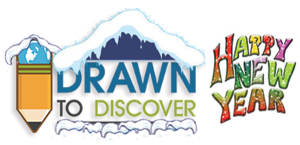


 The topic of handwriting has become more and more prevalent in
The topic of handwriting has become more and more prevalent in 




 What is language at its most basic level? A medium for communicating, correct? Most often we think of language as formal, spoken language like English, Spanish, Mandarin, etc. But even when speaking with others, a large part of our communication is nonverbal – tone, volume, cadence, body language, and facial expressions all play a very large role. Words themselves aren’t everything. Hence the explosion of emoticons with our textual communication J
What is language at its most basic level? A medium for communicating, correct? Most often we think of language as formal, spoken language like English, Spanish, Mandarin, etc. But even when speaking with others, a large part of our communication is nonverbal – tone, volume, cadence, body language, and facial expressions all play a very large role. Words themselves aren’t everything. Hence the explosion of emoticons with our textual communication J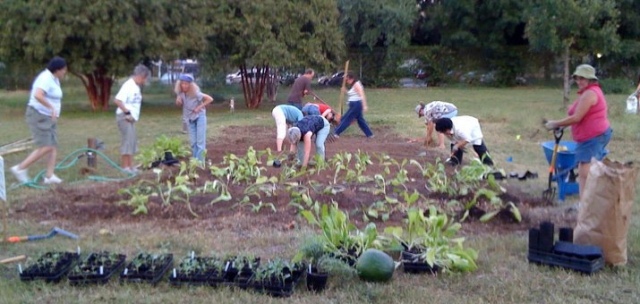

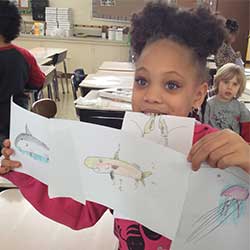

 I used to say that I didn’t have a creative bone in my body. I viewed creativity within a very narrow scope – I had placed it in a box as if I knew what it was (or at least what it wasn’t). At the time, I associated creativity with art or music. Having not developed these faculties within myself, I therefore decided I was not creative.
I used to say that I didn’t have a creative bone in my body. I viewed creativity within a very narrow scope – I had placed it in a box as if I knew what it was (or at least what it wasn’t). At the time, I associated creativity with art or music. Having not developed these faculties within myself, I therefore decided I was not creative.

 As an expectant father, I have lots of hopes and dreams for what kind of father I want to be. For example, I see fatherhood as nurturing growth and development. Fatherhood is about providing guidance and direction that helps a child grow and discover on their own. As a father-to-be, I’m proud to be a part of
As an expectant father, I have lots of hopes and dreams for what kind of father I want to be. For example, I see fatherhood as nurturing growth and development. Fatherhood is about providing guidance and direction that helps a child grow and discover on their own. As a father-to-be, I’m proud to be a part of 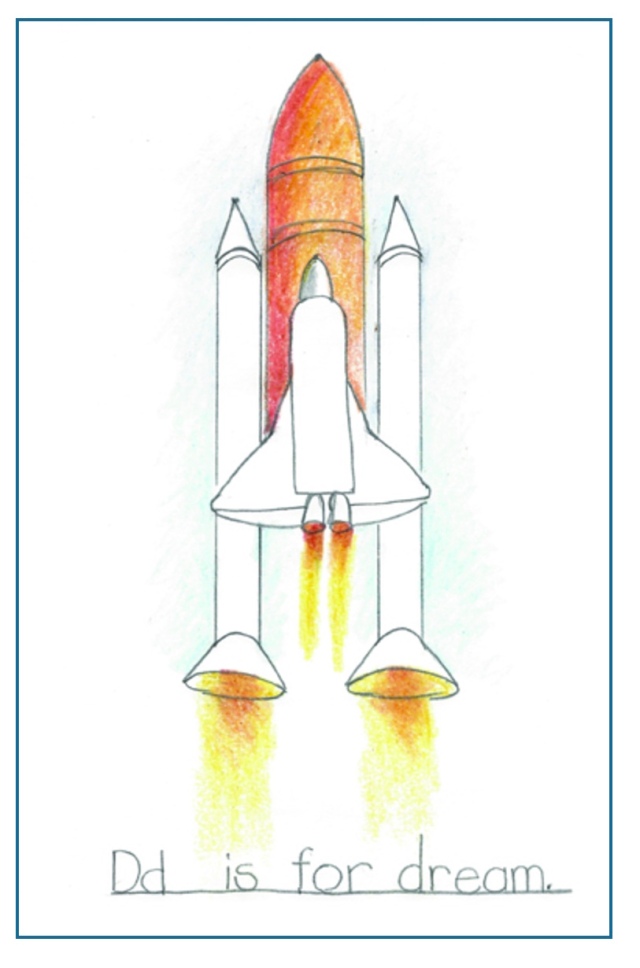 Looking for a cure for the summertime blues? Want to prevent that summer slide? Look no further. I am proud to announce that
Looking for a cure for the summertime blues? Want to prevent that summer slide? Look no further. I am proud to announce that 